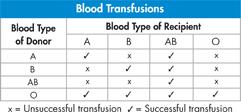Analyzing Data
Blood Transfusions
The first successful transfusion of human blood was carried out in 1818. But many later recipients had severe reactions to transfused blood, and a number died. Today we know why. We inherit one of four blood types—A, B, AB, or O—which are determined by antigens, or the lack of antigens, on our blood cells. Antigens are substances that trigger an immune response. People with blood type A have A antigens on their cells, those with type B have B antigens, those with AB blood have both A and B, and those with type O have neither A nor B antigens.
Transfusions work when blood types match. But they can also work in some cases even when the blood types of the donor and the recipient do not match. Use the table to answer the questions that follow.
Draw Conclusions Which blood type is sometimes referred to as the “universal donor”? Which is known as the “universal recipient”?
Infer In a transfusion involving blood types A and O, does it matter which blood type is the recipient's and which is the donor's?
Apply Concepts Write a brief explanation of the results in the chart using information about phenotypes and genotypes in blood group genes. (Hint: Review Lesson 14.1 if needed.)
The Lymphatic System
 What is the function of the lymphatic system?
What is the function of the lymphatic system?
As blood passes through capillaries, some blood cells and components of plasma move through capillary walls and into the fluid between cells, carrying nutrients, dissolved oxygen, and salts. Each day about 3 liters of fluid, and the small particles it contains, leaves the blood. Most of this fluid, known as lymph, is reabsorbed into capillaries, but not all of it. The rest goes into the lymphatic system.  The lymphatic system is a network of vessels, nodes, and organs that collects the lymph that leaves capillaries, “screens” it for microorganisms, and returns it to the circulatory system. The lymphatic system, shown in Figure 33–10, is also involved in the absorption of nutrients and in immunity.
The lymphatic system is a network of vessels, nodes, and organs that collects the lymph that leaves capillaries, “screens” it for microorganisms, and returns it to the circulatory system. The lymphatic system, shown in Figure 33–10, is also involved in the absorption of nutrients and in immunity.
Role in Circulation Lymph collects in a system of lymphatic capillaries that slowly conducts it into larger and larger lymph vessels. The lymphatic system doesn't have a pump to move lymph along. Instead, lymph vessels have valves, similar to the valves in large veins, that prevent lymph from flowing backward. Pressure on lymph vessels from surrounding skeletal muscles helps move lymph through the system into larger and larger ducts. These ducts return lymph to the blood through openings in the subclavian veins just below the shoulders. When injury or disease blocks lymphatic vessels, lymph can accumulate in tissues, causing swelling called edema.
Table of Contents
- Formulas and Equations
- Applying Formulas and Equations
- Mean, Median, and Mode
- Estimation
- Using Measurements in Calculations
- Effects of Measurement Errors
- Accuracy
- Precision
- Comparing Accuracy and Precision
- Significant Figures
- Calculating With Significant Figures
- Scientific Notation
- Calculating With Scientific Notation
- Dimensional Analysis
- Applying Dimensional Analysis





